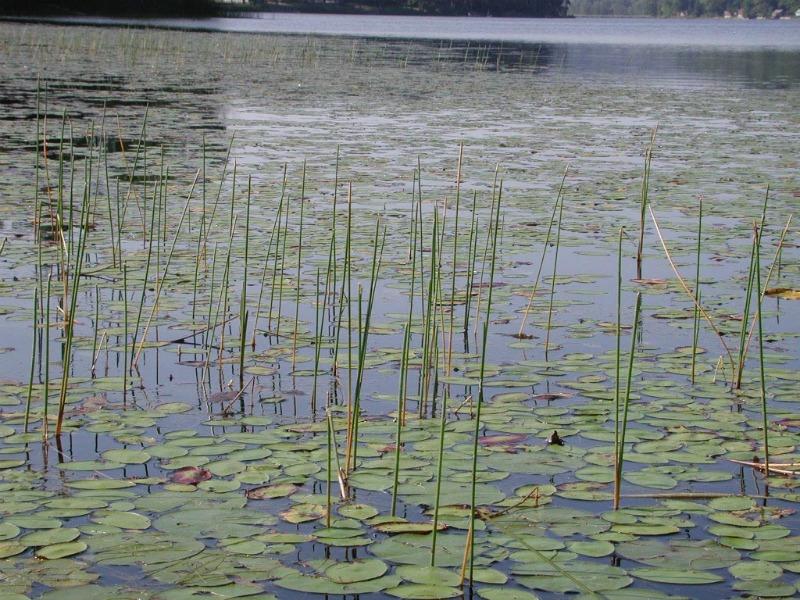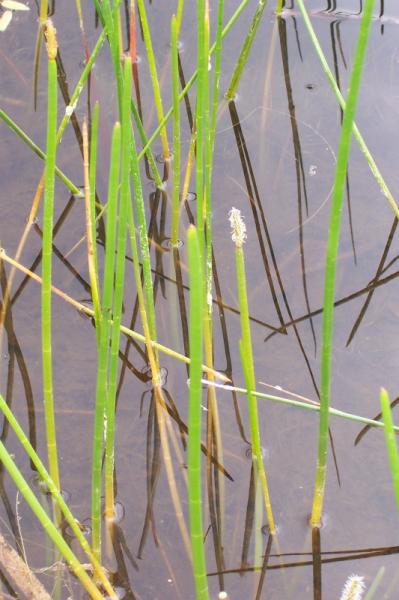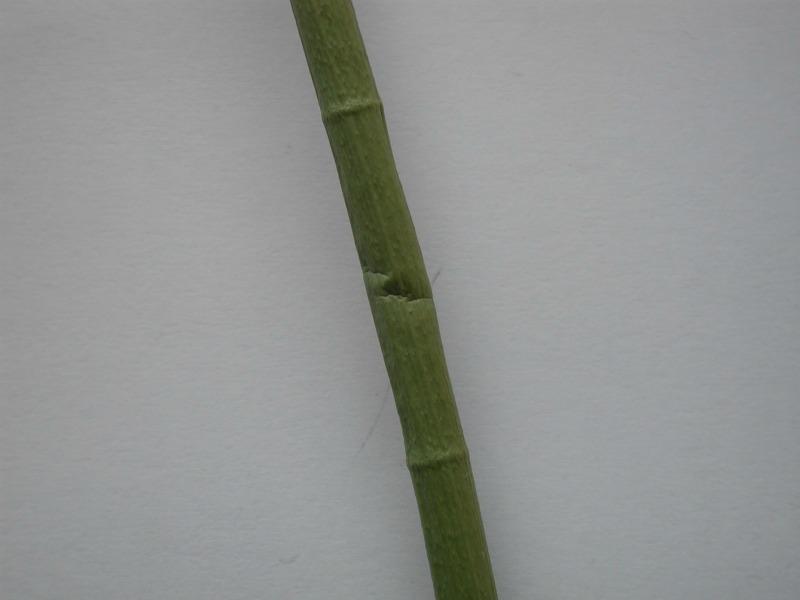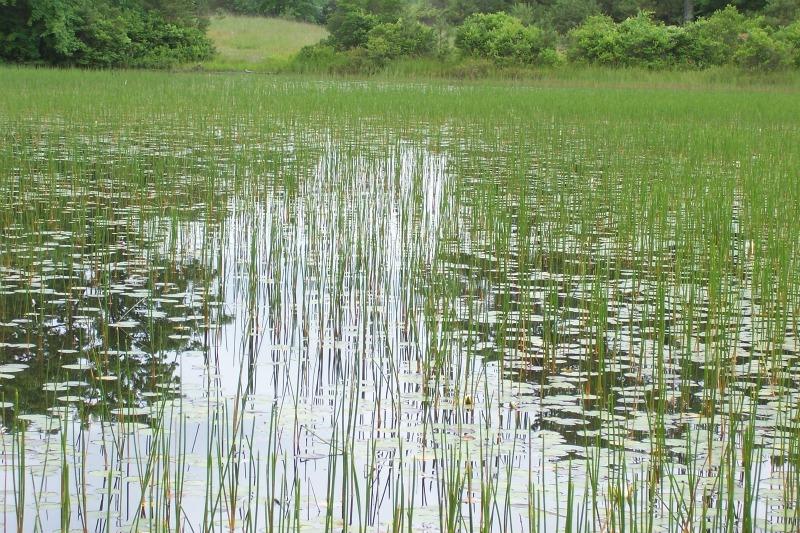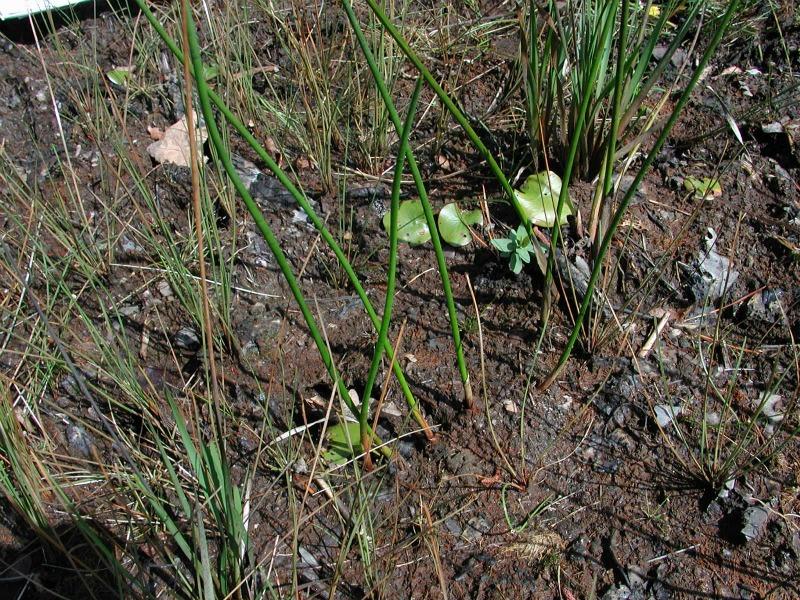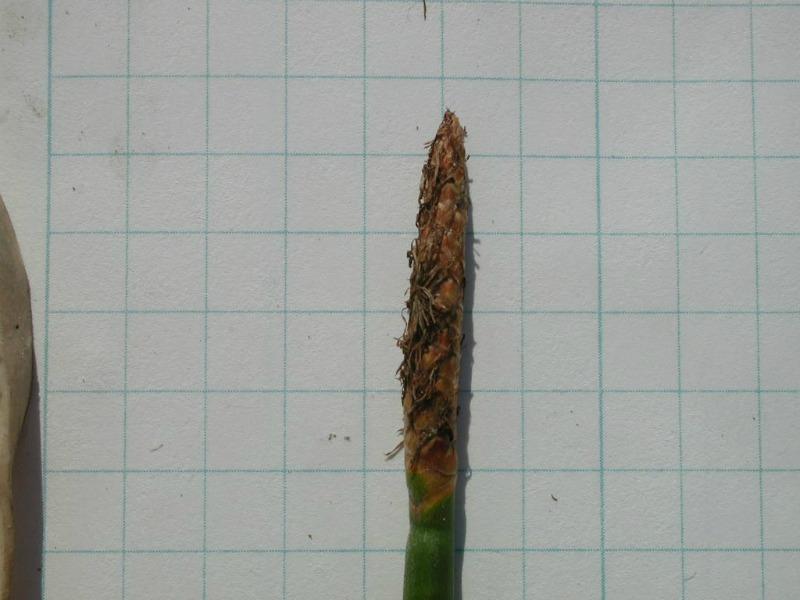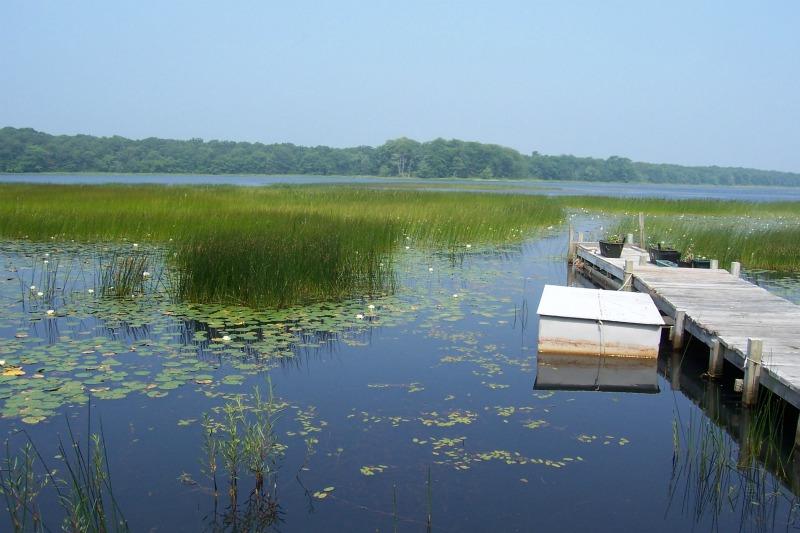Horsetail Spike Rush
Eleocharis equisetoides (Ell.) Torr.
- Class
- Monocotyledoneae (Monocots)
- Family
- Cyperaceae (Sedge Family)
- State Protection
- Threatened
Listed as Threatened by New York State: likely to become Endangered in the foreseeable future. For animals, taking, importation, transportation, or possession is prohibited, except under license or permit. For plants, removal or damage without the consent of the landowner is prohibited.
- Federal Protection
- Not Listed
- State Conservation Status Rank
- S2
Imperiled in New York - Very vulnerable to disappearing from New York due to rarity or other factors; typically 6 to 20 populations or locations in New York, very few individuals, very restricted range, few remaining acres (or miles of stream), and/or steep declines.
- Global Conservation Status Rank
- G4
Apparently Secure globally - Uncommon in the world but not rare; usually widespread, but may be rare in some parts of its range; possibly some cause for long-term concern due to declines or other factors.
Summary
Did you know?
Knotted spikerush is one of the largest and most beautiful of the Eleocharis species in New York. It is the only species with jointed stems marked by light horizontal lines. These joints are what give it its species name which refers to the genus Equisetum, the horsetails, which also have jointed stems.
State Ranking Justification
There are nine existing populations and six of them are in good to excellent condition. Three of them are fairly small and threatened by water birds. There are four historical occurrences which need further checking.
Short-term Trends
The current populations seem to be doing well with no large fluctuations in numbers.
Long-term Trends
More populations now exist than were known historically because of intensive surveys of Long Island in the 1980s. Only a couple of historical occurrences have not been relocated.
Conservation and Management
Threats
A few smaller populations are threatened by browsing by swans or geese.
Conservation Strategies and Management Practices
Establish a buffer around the ponds where it grows to protect their hydrologic régime.
Habitat
Habitat
Most occurrences in New York are in shallow coastal plain ponds, with one from a shallow, sandy-bottomed cove of a larger lake (New York Natural Heritage Program 2007). Shallow water near the coast (Gleason and Cronquist 1991). Shallow water (Fernald 1970).
Associated Ecological Communities
- Coastal plain pond
(guide)
The aquatic community of the permanently flooded portion of a coastal plain pond with seasonally, and annually fluctuating water levels. These are shallow, groundwater-fed ponds that occur in kettle-holes or shallow depressions in the outwash plains south of the terminal moraines of Long Island, and New England. A series of coastal plain ponds are often hydrologically connected, either by groundwater, or sometimes by surface flow in a small coastal plain stream.
- Coastal plain pond shore
(guide)
The gently sloping shore of a coastal plain pond with seasonally and annually fluctuating water levels. Plants growing on the pond shore vary with water levels. In dry years when water levels are low there is often a dense growth of annual sedges, grasses, and herbs. Submerged and floating-leaved aquatic plants, such as fragrant waterlily and pondweeds, may become "stranded" on the exposed shore. In wet years when the water level is high only a few emergents and floating-leaved aquatics may be noticeable. T
- Inland calcareous lake shore
(guide)
The gravelly, sandy, or muddy shore of an inland lake or pond with calcareous water and seasonally fluctuating water levels. There may be few plants and those that are present are usually herbaceous.
Associated Species
- Brasenia schreberi (water-shield)
- Eleocharis robbinsii (Robbins's spike-rush)
- Eriocaulon aquaticum (northern pipewort, northern hat-pins)
- Hydrocotyle americana (American marsh-pennywort)
- Juncus marginatus (common grass-leaved rush)
- Ludwigia sphaerocarpa (globe-fruited seed-box)
- Nymphaea odorata
- Schoenoplectus acutus
- Schoenoplectus subterminalis (water bulrush)
Range
New York State Distribution
Most occurrences of Knotted Spikerush in New York are from the coastal plain on Long Island. There is also a single high-quality occurrence from Dutchess County.
Global Distribution
New York is at the northeastern edge of the range of this species, which is also found in Ontario and southern New England, south along the Atlantic and Gulf Coasts, and scattered through the upper Midwest. It is disjunct to California.
Identification Comments
General Description
Spikerushes consist of a simple stem (the leaves bladeless and inconspicuous), with the infloresence consisting of a solitary, many-scaled spikelet at the top of the stem. The perianth (sepals and petals), if present, is reduced to bristles. The base of the style is expanded into a tubercle, and is usually persistent on the fruit (achenes). Knotted spikerush is perennial from rhizomes. The stems are 50 to 100cm tall and 5 to 8.4mm wide, and septate (separated by lighter-colored transverse partitions across the stem) throughout their length, the divisions becoming closer together towards the spikelet.
Best Life Stage for Proper Identification
This species is best identified when in fruit.
Similar Species
Equisteum interstincta also may have septate divisions near the spikelet, but lacks them near the base of the stem. In its vegetative form.Juncus militaris may also be confused with E. equisetoides Both species have transverse partitions, but Juncus militaris has darker partitions that are closer together, as well as basal sheathing leaves.
Best Time to See
Knotted Spikerush begins flowering in July and fruit may be present from August into October.
- Vegetative
- Fruiting
The time of year you would expect to find Horsetail Spike Rush vegetative and fruiting in New York.
Horsetail Spike Rush Images
Taxonomy
Horsetail Spike Rush
Eleocharis equisetoides (Ell.) Torr.
- Kingdom Plantae
- Phylum Anthophyta
- Class Monocotyledoneae
(Monocots)
- Order Cyperales
- Family Cyperaceae (Sedge Family)
- Order Cyperales
- Class Monocotyledoneae
(Monocots)
- Phylum Anthophyta
Additional Common Names
- Knotted Spike Rush
Synonyms
- Eleocharis interstincta (Vahl) Roemer & J.A. Schultes
Additional Resources
Best Identification Reference
Flora of North America Editorial Committee. 2002. Flora of North America, North of Mexico. Volume 23. Magnoliophyta: Commelinidae (in part): Cyperaceae. Oxford University Press, New York. 608 pp.
Other References
Crow, Garrett E. and C. Barre Hellquist. 2000. Aquatic and wetland plants of northeastern North America: A revised and enlarged edition or Norman C. Fassett's a manual of aquatic plants. Volume two angiosperms: Monocotyledons. The University of Wisconsin Press. Madison, Wisconsin. 456 pp.
Fernald, M.L. 1950. Gray's manual of botany. 8th edition. D. Van Nostrand, New York. 1632 pp.
Gleason, Henry A. and A. Cronquist. 1991. Manual of Vascular Plants of Northeastern United States and Adjacent Canada. The New York Botanical Garden, Bronx, New York. 910 pp.
Haines, Arthur and Thomas F. Vining. 1998. Flora of Maine. A Manual for Identification of Native and Naturalized Vascular Plants of Maine.
Holmgren, Noel. 1998. The Illustrated Companion to Gleason and Cronquist's Manual. Illustrations of the Vascular Plants of Northeastern United States and Adjacent Canada. The New York Botanical Garden, Bronx, New York.
New York Natural Heritage Program. 2010. Biotics database. New York Natural Heritage Program. New York State Department of Environmental Conservation. Albany, NY.
New York Natural Heritage Program. 2024. New York Natural Heritage Program Databases. Albany, NY.
Voss, E.G. 1972. Michigan Flora, Part I. Gymnosperms and Monocots. Cranbrook Institute of Science Bulletin 55 and the University of Michigan Herbarium. Ann Arbor. 488 pp.
Weldy, T. and D. Werier. 2010. New York flora atlas. [S.M. Landry, K.N. Campbell, and L.D. Mabe (original application development), Florida Center for Community Design and Research http://www.fccdr.usf.edu/. University of South Florida http://www.usf.edu/]. New York Flora Association http://newyork.plantatlas.usf.edu/, Albany, New York
Weldy, Troy W. and David Werier. 2005. New York Flora Atlas. [S.M. Landry, K.N. Campbell, and L.D. Mabe (original application development), Florida Center for Community Design and Research. University of South Florida]. New York Flora Association, Albany, NY. Available on the web at (http://newyork.plantatlas.usf.edu/).
Links
About This Guide
Information for this guide was last updated on: January 18, 2008
Please cite this page as:
New York Natural Heritage Program. 2024.
Online Conservation Guide for
Eleocharis equisetoides.
Available from: https://guides.nynhp.org/knotted-spike-rush/.
Accessed July 27, 2024.
